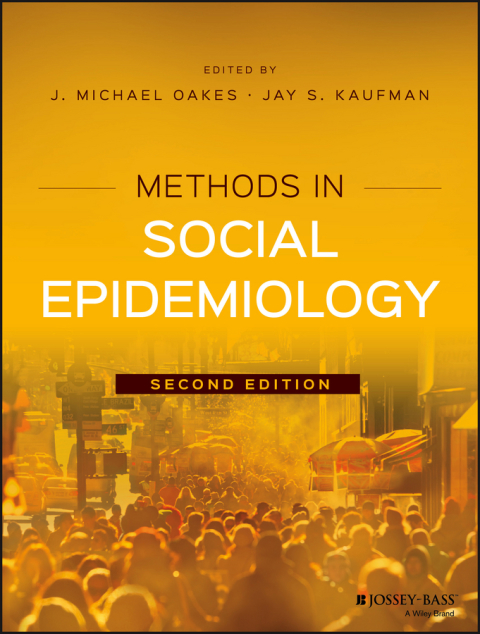Description
Efnisyfirlit
- Cover
- Title Page
- Copyright
- Dedication
- Tables and Figures
- About the Editors
- About the Authors
- Preface
- Chapter 1: Introduction: Advancing Methods in Social Epidemiology
- What Is Social Epidemiology?
- What Is Social Epidemiologic Methodology?
- Three Fundamental Issues
- Advancing Further Still
- References
- PART ONE: MEASURES AND MEASUREMENT
- Chapter 2: The Measurement of Socioeconomic Status
- What Is Socioeconomic Status?
- Why Does it Matter?
- How Is SES Measured?
- How Should SES Be Measured?
- Recommendations and Conclusions
- References
- Chapter 3: Measuring and Analyzing “Race,” Racism, and Racial Discrimination
- Concepts
- Measurement
- Conclusions
- References
- Chapter 4: Measuring Poverty
- What Does It Mean to be Poor?
- Early Attempts at Constructing Poverty Budgets (Thresholds)
- Current Methods of Poverty Measurement
- NRC Panel Recommendations
- Impact on Elderly and Child Poverty
- Progress Toward Adoption of a New Poverty Measure
- Conclusions
- References
- Chapter 5: Health Inequalities: Measurement and Decomposition
- Issues
- Measures
- Decomposition of Inequalities
- Conclusions
- References
- Appendix
- Chapter 6: A Conceptual Framework for Measuring Segregation and Its Association with Population Outcomes
- What Is Segregation?
- Why Does Segregation Matter?
- Conceptual and Methodological Issues in the Measurement of Segregation
- Measures of Residential Segregation
- The Association of Segregation with Population Outcomes
- Summary
- References
- Chapter 7: Measures of Residential Community Contexts
- Measurement Strategies for Residential Neighborhoods
- Observational Measures of Neighborhoods
- Measures on Perceptions of Neighborhoods
- Bringing in the Community Perspective
- Future Directions on Measuring Neighborhood Environments
- References
- PART TWO: DESIGN AND ANALYSIS
- Chapter 8: Community-Based Participatory Research: Rationale and Relevance for Social Epidemiology
- Definition and Principles of CBPR
- CBPR and Social Epidemiology
- Deciding Whether or Not to Use a CBPR Approach
- The Process of CBPR
- Common Pitfalls/Challenges and Facilitating Factors in CBPR
- Discussion
- Conclusion: “Push Beyond the Research”
- Acknowledgments
- References
- Chapter 9: Social Network Analysis for Epidemiology
- Introduction to Network Concepts
- Study Design and Data Collection Methods
- Analytic Approaches
- Future Directions for SNA
- Conclusions
- Acknowledgments
- References
- Chapter 10: Fieldwork with In-Depth Interviews: How to Get Strangers in the City to Tell You Their Stories
- Logistics
- How to Talk to Strangers So It Does Not Feel Strange
- Conclusion: One Size Does Not Fit All, and Try, Try, Again
- Acknowledgments
- References
- Chapter 11: Experimental Social Epidemiology: Controlled Community Trials
- Randomization and Dependence
- Implications of Clustering—Proper Inference in Community Trials
- Efficient Allocation of Resources Subject to Constraints
- Example of Designing a GRT and Some Further Issues
- Implementation of Randomized Community Trials
- Summary
- References
- Chapter 12: Propensity Score Matching for Social Epidemiology
- The Counterfactual Framework
- Propensity Score Matching Methods
- Worked Example
- Conclusions
- References
- Chapter 13: Longitudinal Approaches to Social Epidemiologic Research
- Analytic Approaches to Describe Longitudinal Patterns
- Analytic Approaches to Address Sources of Bias in Longitudinal Research
- Conclusion
- References
- Appendix 1. MPLUS Code for Unconditional Growth Model
- Appendix 2. MPLUS Code for Growth Model with Covariates
- Appendix 3. SAS Code for Hierarchical Age–Period–Cohort Model Described in Figure 13.5
- Appendix 4. SAS Code to Estimate Inverse Probability of Treatment Weights
- Appendix 5. SAS Code to Estimate Marginal Structural Models
- Chapter 14: Fixed Effects and Difference-in-Differences
- Methods
- Applications
- Conclusion
- Key Readings and Resources
- Acknowledgments
- References
- Chapter 15: Fixed Versus Random Effects Models for Multilevel and Longitudinal Data
- Between Versus Within Cluster Variables
- Fixed Effects
- Random Effects
- Hybrid Effects
- Marginal Models
- An Applied Multilevel Example and Comparison of Results from Different Models
- Multilevel and Longitudinal Literature Examples
- Summary and Recommendations for Further Reading
- References
- Chapter 16: Mediation Analysis in Social Epidemiology
- The Product Method for Mediation Analysis
- Counterfactual Approach to Mediation Analysis
- Controlled or Natural Effects?
- Decomposition of Racial Inequalities in Health
- Exposure-Induced Mediator-Outcome Confounding
- Mediation Analysis with Multiple Mediators
- Sensitivity Analyses
- Other Topics
- Conclusions
- References
- Chapter 17: A Roadmap for Estimating and Interpreting Population Intervention Parameters
- Roadmap
- Other Parameters and Future Directions
- Conclusions
- Acknowledgments
- References
- Chapter 18: Using Causal Diagrams to Understand Common Problems in Social Epidemiology
- Some Background Definitions
- Graphical Models
- Applying DAGs to Guide Analyses in Social Epidemiology
- Caveats and Conclusion
- Acknowledgments
- References
- Chapter 19: Natural Experiments and Instrumental Variables Analyses in Social Epidemiology
- Motivations for Using Instrumental Variables in Social Epidemiology Research
- Assumptions and Estimation in IV Analyses
- Framing Natural Experiments and IVs Causally
- A Good Instrument Is Hard to Find
- Limitations of IV Analyses
- Conclusion
- References
- Index
- End User License Agreement





